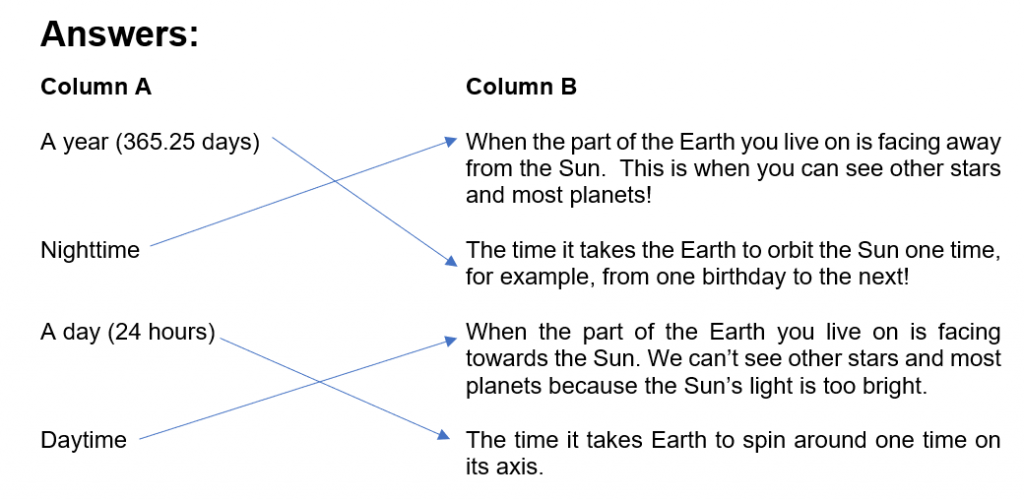Welcome back! Last month we took a look at what’s up in the sky. This month we are staying on the ground and checking out our home — planet Earth. Have fun!
What on Earth??
Unless you’re an astronaut living on the International Space Station (ISS), you, and everyone you know, live here on planet Earth. It is one of 8 planets that go around (orbit) the star that we call our Sun. Earth is the third planet from the Sun, which is 150 million km away. Earth is special!! We haven’t found life anywhere else in the Universe…yet!
Most of our Earth home is covered by water (71%) and ice (10%)! It is surrounded by an atmosphere 515 km thick which is made of gases. This atmosphere is like a blanket surrounding the Earth, protecting it from the Sun’s radiation, balancing our surface’s temperature and more! Earth is 12,756 km across.
As the Earth travels around the Sun, it also spins toward the East! It spins very fast at 1,600 km per hour! Imagine a line going right through the middle of the Earth from North to South. This is called the Earth’s axis.
You can see that the axis doesn’t go straight up and down, and is tilted by 23.5° (degrees). This tilt and Earth’s orbit around the Sun are the reasons why we have four seasons!
Time to put on your thinking caps! Match Column A with Column B:
During February, see how many of these you can see in the sky:
1. Any Clear Night: The Constellation Orion: Constellations are patterns formed by stars in the sky. Orion, also called the Hunter, appears in the February sky all evening. Orion’s belt and sword are easy to see in the night sky!
2. Mars and the Moon along with the Pleiades and some bright stars: On the evening of February 18th around 6:30 p.m. and afterwards, look up high in the southern sky to see the Moon near Mars. You will also see some bright stars, like Betelgeuse and Rigel in Orion (see above), and Sirius, also called the Dog star. If you look carefully, you may also see a fuzzy patch above the Moon called the Pleiades, a group of stars also called the Seven Sisters.
Things to do until next time**:
1. Visit www.solarsystemscope.com where you can see what it looks like as the Earth and other planets actually move around the Sun.
2. Visit NASA’s Space Place: https://spaceplace.nasa.gov/menu/earth/ This month you will learn more about the Earth. You could even make your very own Stained-Glass Earth! https://spaceplace.nasa.gov/stained-glass-earth/en/
3. Watch this YouTube video about why we have 4 seasons: https://www.youtube.com/watch?v=UQjT5uKp2hg
4. Mind Benders:
• What would happen if the Earth didn’t spin on its axis?
• What would happen if the Earth was not tilted on its axis?
• What if the Earth spun in the opposite direction?
• Do the stars travel across the night sky?
• Why can’t I see stars during the day?
5. Have a look at this video of Earth taken from the ISS during 2020. There are some amazing views!! https://t.co/k90COvWXei https://t.co/cGd95Dj4yF
** Check with your parents or caregivers before checking out websites.
Finally:
What type of hair do Earth’s oceans have?? (answer below)
See you next month!
If you have a question you would like answered in the newsletter, please send it to education@amateurastronomy.org
Answers to Mind Benders:
- What would happen if the Earth didn’t spin on its axis?
Answer: One half of the Earth would always have daytime, and the other half would always have nighttime. Which side would you like the best?
- What would happen if the Earth was not tilted on its axis?
Answer: We would not have 4 seasons every year. Each area of the Earth would be stuck with one of the 4 seasons all the time. Which season would you like the best?
- What if the Earth spun in the opposite direction?
Answer: The Sun, Moon and stars would appear to rise in the West and set in the East instead of the way we see it now, which is from East to West!
- Do the stars travel across the night sky?
Answer: No. It appears as though the stars are moving across the night sky from East to West. It is actually the Earth spinning on its axis and moving towards the East…so we are moving at 1,600 km per hour and not the stars!!
- Why can’t I see stars during the day?
Answer: Stars are all around us, we just can’t see them during the day. We can only see them at nighttime when we are facing away from the Sun. The sun’s light is too bright and we can’t see past the Sun to see stars.
What type of hair do Earth’s oceans have??
Answer: Wavy!_
__________________________________________________________________
References:
Astronomy.com: Astronomy for Kids. 2019.
National Geographic Kids: Ultimate Space Atlas. 2017.
National Schools Observatory: https://www.schoolsobservatory.org/learn/astro/esm/seasons/e_tilt








I was outside on my break at approx 1130PM.
I was looking toward the s w sky.
I saw an burning orange with a tail, orange as well
About 2 weeks ago.
I’ve been wondering if it was a meteor and did anyone else see it
Hi Ann: A fireball was observed by some people in Southern Ontario on Wednesday, January 27th at around 11:30pm EST. This is a website where people record fireballs if they see them: http://fireballs.amsmeteors.org/members/imo_view/event/2021/574
Maybe it’s the same one you saw!?